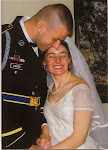Catechetical Sermon Four: Holy Tradition and our traditions
Preached at St. John’s Lancaster, 14 November 2010
Rebecca and I have always kept small aggressive dogs who are wonderfully loving. Their skin is generally black, and their coats are coarse and thick, but they don’t shed. They have small, upright ears and alert eyes. They spell immediate death to any rodent on which they manage to fixate. They will sit under a tree for hours or dig two to three times their body length in search of prey. They are not for everyone, and many people who acquire these breeds of dogs without doing their research before their purchase end up giving them away. All of you who have been around dogs know that I am talking about terriers. The definition, like the experience of owning them, is unmistakable and absolutely predictable. Tradition, and traditions are like that. They often aggravate us, they almost always comfort us, they are often a mystery to others, and they define who we are.
When we employ the word tradition, we are actually talking about two different things. Big “T” Tradition,, which is often called Holy Tradition, is that way of doing things which we have received from the Apostles, and which St. Paul admonished us to hold fast. It involves the way we organize our Church structures into Dioceses with Bishops in Apostolic Succession, represented by Priests and assisted by Deacons. It is evident in our insistence on the use of the same elements that Jesus used in the Holy Communion, and in our insistence that the words of Scripture be employed in the Eucharistic Prayer. It defines why we insist on saying the Apostles’ Creed at Baptisms and the Nicene Creed at Communion. It informs our understanding of the intricacies of our understanding of the Holy and Blessed Trinity and of the Union of the Divine and Human Natures in the Person of our Lord and Saviour Jesus Christ. It involves our insistence that believers do their very best to live lives of obedience to the clear teachings of Holy Scripture. Little “t” traditions are very different from big “T” Traditions. They involve those theological comfort items that give us a sense of having been in church, and in the presence of God. They include things like the use of organ and English choral music, the lighting of candles, when we cross ourselves, and how we bow. Liturgical colour schemes and the installation of pews in our Naves also fall into the “little t” category.
It goes without saying that Holy Tradition constitutes a body of practice which we dare not change on our own or without sincere and prayerful consideration. In fact, it would be consistent with the ancient teachings of the church to say that any attempt to change the Holy Traditions of our Holy Mother the Church without the full consultation and consent of our Anglican and Ecumenical Brothers and Sisters, including as the Romans, the Orthodox, the Copts, the Syriac, and the Protestant Churches, any such action would be arrogant and prideful, and would represent a willful walking apart from that consensus which defines us as the Body of Christ.
But that is enough of the heavy theology. Let’s talk about some of those fun things which define us, and which help us to express more fully our commitment to Christ. Keep in mind that these things we will talk about are not required, but they are loved by many faithful men and women, because they have often defined who we are as this people of God called Episcopalians, or Anglicans.
1. The sign of the Cross. The sign of the Cross is a reminder of the signing with the cross that we experienced at our Baptism. Here are some of the times that people have come to consider it appropriate to sign themselves
At the conclusion of your devotions after entering the church
At mention of the Resurrection of the Body in the Creed
At the absolution in Prayers or Communion
In the Communion prayer when we acknowledge ourselves as being in Christ
Before receiving the elements in Communion
At the beginning of the canticles in Morning or Evening Prayer
Whenever you hear an ambulance or pass a funeral
In short, whenever life’s events call you to remember the grace of God in your life.
2. To genuflect or to Bow. Either is acceptable and appropriate at any time you cross the line of the cross in a procession or while moving about the church. It is simply a matter of giving Royal Honours to God. On the continent, subjects generally knelt before King or Emperor, and therefore the catholic custom is to genuflect, and that is perfectly acceptable. In the British Isles, it was customary to greet one’s sovereign with a low Stuart bow. Hence many in our Communion execute a solemn bow.
3. Facing East in the Creed. We face east during the Creed because we believe that Jesus will return to Jerusalem, and therefore we face east in anticipation of this event. While facing east, it is customary to bow when the article about Jesus begins, again as a sign that we are indeed His liege men and women.
4. Covering or uncovering in Church. It was the custom of the apostolic church, and is still the custom in most Christian places, that men have their heads uncovered during prayer and women have theirs covered. Saint Paul talks about this custom, and until very recently, it was the norm even here at St. John’s. But again, it is a devout custom, not a requirement.
5. Entering the church in silence. Customarily, Anglicans and Episcopalians, and most other liturgical Christians, assume an attitude of prayer when entering the church and refrain from talking to each other until after the service. This custom is designed to show our respect to God and to give us time to prepare our hearts to worship Him in an undivided manner.
6. To kneel or to stand. Both customs are presented by the prayer book rubrics, or instructions. The medieval western custom was to kneel for confession and prayer, sit for instruction, and stand for praise. An early eastern custom (and remember that the Churches of Britannia and Hibernia originally gave obeisance to the Patriarch of Jerusalem, not to that of Rome) called for Christians to stand whenever they addressed God. The choice is yours.
Is your brain full and your head spinning yet? I’ll assume that it just might be. So let me summarize a couple of general principles that might help you to put these “little t” traditions into perspective.
1. Lots of people have found that sharing these traditions helps them to feel like a part of something much larger than themselves, to feel God’s presence more immediately in their worship experience, and to identify with a particular Christian worshipping tradition.
2. If you find them helpful in those or other ways, then do them.
3. If you don’t find them helpful, then don’t do them.
4. Follow your heart, and God will bless you.
But now, let us consider our traditions and Tradition in a more serious light. Do the things we do help people to see that we are indeed Christians? ( Like the characteristics and physical features of a terrier mark it out as one.) And more importantly, are the fruits of the Spirit, especially Love, so evident in my life that my witness is seen as being consistent with the customs I practice. If that is not the case, I will be seen as a hypocrite, and my recognition as a follower of Christ may well do more harm than good. So, go forth to keep seriously and devoutly those Holy Traditions we have received from the Apostles. Participate in those “little t” traditions which give you a sense of belonging and feeling closer to God. And in all things, as the song says, let them “know we are Christians by our Love.” In the Name of the Father, and of the Son, and of the Holy Ghost. AMEN.
Sunday, November 14, 2010
Subscribe to:
Post Comments (Atom)












No comments:
Post a Comment